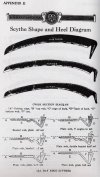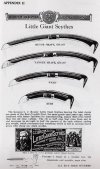In illustration No. 6 a demonstration is given of cutting a 11 feet sward of lucerne at the point of entering the crop. Both arms are outstretched fully with the swing to the right. The point of the scythe blade must lie in a straight line with the heel of the right foot when the first movement is made, and on finishing the swing the blade is in line with the heel of the left foot. The left hand kept on the handle must be opposite the left hip-joint and maintained firmly in this position during the progress of the blade in the swing round, until finished. This position should be rigidly maintained. To allow it to get lower or higher, the point of the blade gets out of line and sticks in the ground. It may result in snapping it. If the left hand be permitted to extend away from the body the blade will drag and fail to cut.

The illustration No. 7 gives a full view of the mower finishing the swing on a 11 feet sward, or completing the cut. Here we notice the handle of the scythe and its relationship to the body and heel of the mower. The mower's toe on the left foot is raised on entering the sward, and as the blade swings round the cut is finished with the toe raised on the right foot.
These positions are distinct and correct; but in No. 8 we have evidence of the false or awkward position of the mower, in which he cuts a false, poor, or chopping sward only 4 to 6 feet wide.
A class of students is at work in No. 9. The cut is an average of 10 ft. 6 in. of lucerne. The crop was 18 inches long. They worked from 7:30 to 11:30 a. m. and 1 to 5 p.m., and each student averaged 2-1/2 acres per day after a week's practice with the scythe. An expert mower of mature age would cut from 4 to 4-1/2 acres in the same time.

After securing the correct idea of setting a scythe blade to meet the needs of the ground and crop, it is important to note that the handles are placed in correct position to ensure a well-balanced movement. In each case the handle for the right hand should be so transfixed and adjusted that, when taken up on the index finger, it will balance and hang evenly. To keep the blade in true cutting order, a scythe stone is used, and it is in these operations of sharpening proper dexterity is essential. A sharp, fine-grained stone should be selected. To sharpen the blade place the point in the grass on the left-hand side, grasp the heel firmly with the palm of the left hand, and with the right work the scythe stone, which is about 14 inches long. Make sliding strokes downwards on each side alternately with the stone. Keep it flat on the blade and avoid turning the edge. The last stroke of the stone should always be on the side which hugs the sward. When using the stone slide the hand halfway down the blade and rest the elbow against the blade to keep it rigid. The sliding strokes downwards acts on the edge of the blade and converts it into a series of minute teeth like a saw and provides a keen cutting edge. The sharpening operation commences at the heel and proceeds evenly downwards until the point is approached ; when the blade has to be raised and supported to sharpen the final few inches, the strokes are shorter and sharper with the stone. Care should be taken to effect sharpness on the point. Pass the thumb gently along the whole edge of the blade to ascertain if the edge be equally keen all through.
In No. 10 we see the operation in its various stages.
--quoted from
Agricultural gazette of New South Wales, Volume 17 (Google eBook)
New South Wales. Ministry of agriculture, 1908
http://books.google.com/books?id=njALAQAAMAAJ&dq=scythe%20lessons&pg=PA263#v=onepage&q=scythe%20lessons&f=false

